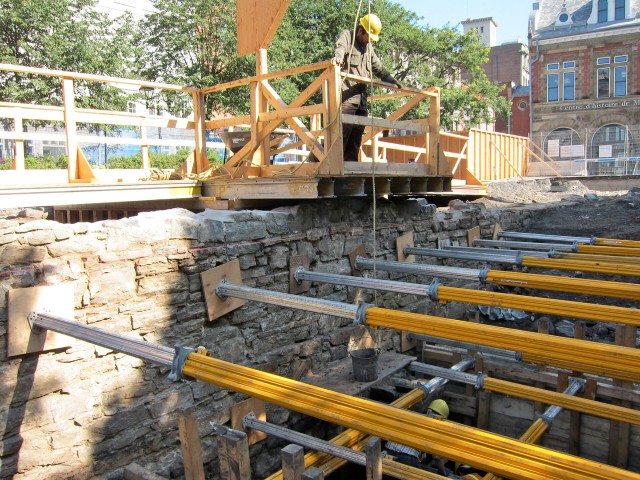Archaeological research
Research programs as part of the expansion project

Since 2010, the Museum has undertaken archaeological and historical research of great importance on the St. Ann’s Market and the Parliament of the United Province of Canada heritage site in Old Montréal. Archaeological digs on the site – a former parking lot – have archaeologists to document ruins conserved some five metres below ground.
Archaeologists have updated archaeological collections dated back to activities on St. Ann’s Market between 1832 and 1843 and between 1850 and 1901 and of the Parliament of the United Province of Canada from 1844 to 1849. Spectacular items related to the burning down of the Parliament on April 25, 1849 have been unearthed, most notably scorched fragments of books from the library of the Legislative Council and House of Assembly. These books are currently being restored at the Canada Conservation Institute. Other objects relate to parliamentary life and include eyeglasses, inkwells, dishes used in the parliamentary restaurant among other items found on the site.
As well, Pointe-à-Callières has partnered with the Laboratoire d’histoire et de patrimoine de l’UQAM to research the documentary archives related to the history of St. Ann’s Market and the parliament (Montréal, A capital, A Parliament) as part of a larger project Montréal, plaque tournante des échanges thanks to a grant from the Social Sciences and Research Council of Canada (2012-2017). The grant has allowed historians, doctoral and master’s students and collaborators from the Université de Sherbrooke to participate in the project.
Phase 3 of the Museum expansion will benefit significantly from the incredible discoveries that have resulted from this archaeological and historical research. The goal is to showcase in situ the vestiges of the market and the parliament as well as the related collections on Montréal and Canada’s social and political life prior to Confederation.
Archaeological Field School
The Archaeological Field School came into being in 2002 thanks to a partnership between Pointe-à-Callière and the Department of Anthropology at the Université de Montréal in collaboration with Concordia University. Until 2014, the school welcomed summer interns who relived history by searching for artefacts dating back to the founding of the city.
Located in an vacant warehouse on Place D’Youville, the program provided the opportunity, over several years, to conduct a systematic dig on the site of Montréal’s birthplace (1642-1680), the de Callière property (1680-1765) and the commercial occupation of the 18th and 18th Centuries. The research, combined with digs competed in 2015 under the street in from of the building, made it possible for the first time to delineate the area of the Ville-Marie Fort, the buildings it contained and the activities that went on within its walls.
These are major discoveries in the history of Montréal and of New France, and the public will be able to discover it as well when the site open on May 17, 2017, the date the Ville-Marie Fort will be inaugurated.
The presence of our Indigenous People, their cohabitation with the French, the change in the colonial regime, the economic boom of the 19th Century are an integral part of our history contextualized and brought to life in a new era by the dig, the documents and the materials that have been unearthed and catalogued.
The project, financed as part of the Agreement on the Cultural Development of Montréal is contributing to the advancement of archaeological research and scientific knowledge on Montréal’s birthplace. It also represents an important partnership between the Museum and the Université de Montréal to advance archaeological research of the metropolitan area and has given students access to an exceptional learning environment at an archaeological site in the heart of the city. These internships have allowed archaeology students to learn first-hand about dig methods and the various ways to share their findings.





